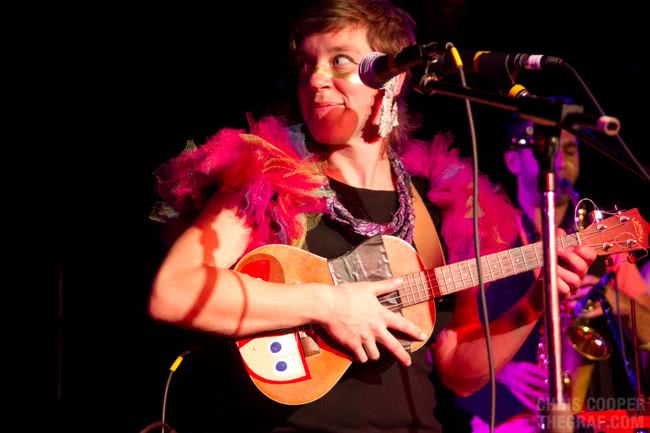There comes a magical time in every reviewers writing life when the usual flood of ideas turns into a tsunami. This is also known as a moment of creative alignment, or as holy-balls-that-gig-was-so-freaking-awesome-I-literally-can’t-imagine-leaving-out-any-one-moment-since-it-was-all-so-pivotal-to-the-awesomeness.
With an act like Merrill Garbus aka Tune-Yards(also stylised tUnE-yArDs) the urge to resist writing a novel based on this – a sideshow sighting at Richmond’s Corner Hotel – is on holiday somewhere. Garbus has flown the Pacific to join the efforts of Melbourne’s Sugar Mountain Festival and informs us that this is only her second show in Australia, ever. Considering her newly minted reputation as one of the best live acts to see, ever – rumor thread starting here – it is clearly a grand occasion.
The moniker Tune-Yards may be a little hard to remember because it is nowhere near as interesting as Garbus, her assembly of eclectic band mates or the music she’s created over the past few years, but it does stimulate conversation.
“My cab driver from the airport thought the name was Two Yards and suggested I change it to ‘Two Metres,” she recounts to a modest but energised audience. Even so, the crowd responds as the native New Englander enters a brightly lit stage, no frills. People call out or scream or grab their neighbours hand in anticipation. This is a big deal for many, to experience the aural complexities of such a unique outfit live.
When Garbus first takes to the mic, she pours a sonic symphony over our ears that is so rich and intricate its hard to imagine its only coming from her small frame. The melody is tribal, almost like an American slave song, but pulses between other odd melodies and percussion. She even imitates a didgeridoo to near perfection. Just her vocals, the washing of white light and a still, breathless crowd.
Garbus wears neon yellow lines of face paint underneath her eyes, as well as a puffy-sleeved 80s styled dress that makes her look like a tropical bird. Members of the audience are also wearing face paint, and it is at this point it becomes painfully clear how devoted to Garbus these people are – and for good reason.
After a moment of stillness, a bass player and two saxophonists take to the stage. Garbus grabs her drum sticks, positions herself in front of a set of mic stands confidently and launches into the set as if she could do it in her sleep. She is a natural born performer.
She plays two rather large drums a bit clumsily, but this is intentional. Her sound is a wash of imperfections that are somehow made perfect when they’re all put together. Garbus loops her own vocal lines to make complex harmonies that she controls seamlessly by pedal. She also orchestrates to her band mates who seem to play freeform or are so well-practiced they only make it look like they are – though the music is far too subtle to suggest the latter. It seems precise but still feels improvised and organic. This becomes evident when Garbus’ facial expressions and the occasional laugh tell us they’ve made a mistake, though we’d never know otherwise.
Tune-Yards’ first album Bird-Brains was made using a hand-held recorder and first released on cassette tape. It’s easy to understand how, in these over produced times, her music might be obscured by its sheer creativity. But what’s even more outstanding about Tune-Yards is how absolutely talented they are as an outfit in the live arena.
Garbus’ voice really stands out on songs “Gangsta” and “Bizness” off her sophomore album, Who Kill, which is a more mature take on her vocal prowless. To add two saxophonists to the mix who not only echo and harmonise very similarly to her vocal looping, but make the vibe in the house all the more funky, steps up our live experience of the music.
After a few songs into the set, the complexities of the music and disharmonies, or what sound like disharmonies to our western ears anyway, are revealed to be largely African influenced. There are both East and West African harmonies and rhythms in the music that are undeniable, yet Tune-Yards marries them in such a way that they feel uniquely her own.
The peak of the performance comes when we the audience are encouraged to join their efforts. We’re instructed to sing one single note that hums underneath Garbus’ silky vocals and hard hitting rhythms and suddenly we’re a part of the band, if only for a fleeting 20 seconds or so.
The show was beautifully experimental but still very aurally satisfying. Sometimes those who look to theory and away from sentiment lose sight of listeners when it’s clear that Tune-Yardsonly has us in mind.
– Cayce Hill

Get unlimited access to the coverage that shapes our culture.
Subscribe to Rolling Stone magazine
Subscribe to Rolling Stone magazine



































